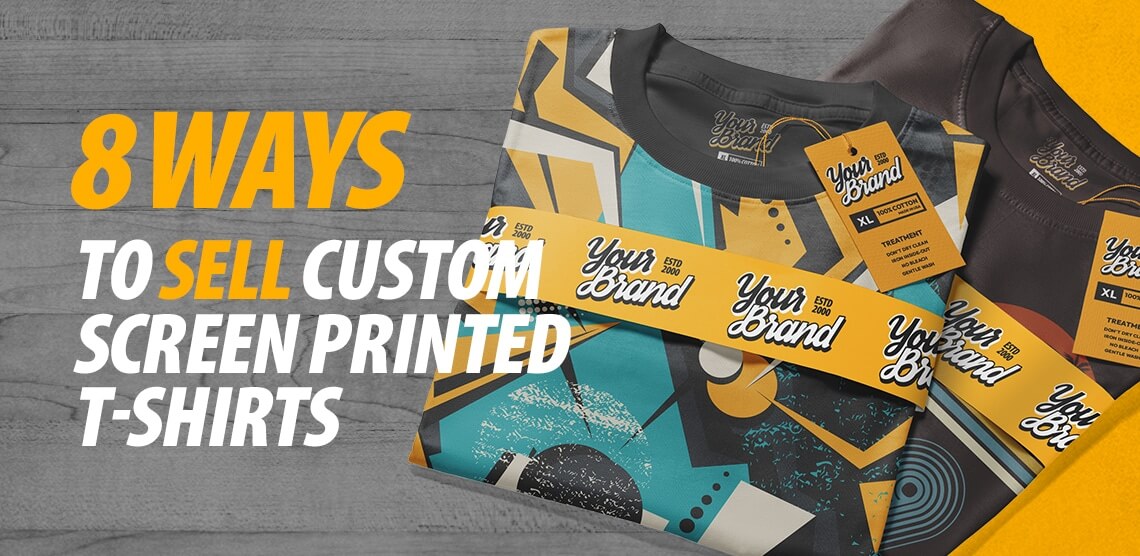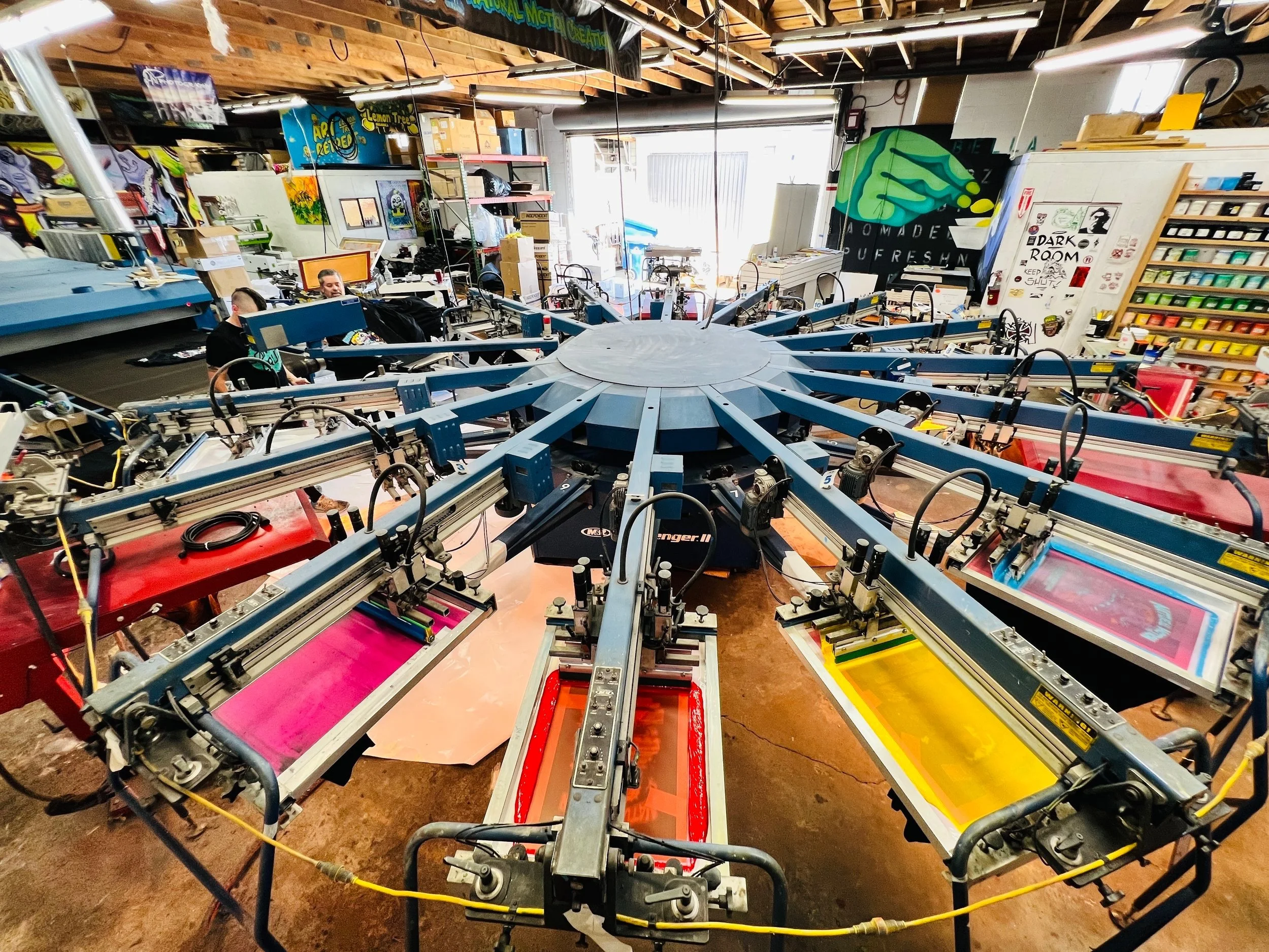High-Quality Custom Screen Printing for Team Apparel
High-Quality Custom Screen Printing for Team Apparel
Blog Article
Screen Printing Uncovered: Whatever You Required to Know Regarding T-Shirt and Garment Printing Techniques
If you have actually ever before asked yourself how those lively styles wind up on your favored t-shirts, you're in the appropriate place. Display printing is a fascinating method that incorporates art with strategy, supplying endless opportunities for creativity. Recognizing the principles, from equipment to ink selections, can significantly affect your results. Ready to explore the necessary aspects that make screen printing an art form? Let's reveal the information that can raise your jobs.
The Basics of Display Printing: Just How It Works
When you plunge into screen printing, you'll find it's both a science and an art. At its core, display printing involves creating a pattern, or screen, that allows ink to pass with just in specific areas.
Placement the display over the textile, after that make use of a squeegee to press ink via the display onto the garment. Each step is essential, and understanding them will raise your display printing skills, changing straightforward garments into one-of-a-kind, meaningful items.
Sorts Of Screen Printing Techniques
As soon as you comprehend the basics of screen printing, it's time to check out the numerous techniques that can raise your styles. One popular method is conventional display printing, where ink is pushed with a stenciled screen. This strategy is excellent for bold, dynamic colors. After that there's water-based ink printing, which supplies a softer feeling and is green, but it calls for a different strategy to treating.
If you're intending for great details, take into consideration discharge printing. This method gets rid of dye from the textile, leaving a soft, classic look. Another alternative is plastisol printing, understood for its durability and vibrant colors, making it a preferred for several brands. Experiment with halftone printing to produce slope results and intricate designs. Each strategy has its one-of-a-kind charm, so don't wait to try them bent on find what suits your style best!
Important Equipment for Screen Printing
To achieve magnificent results in screen printing, having the best equipment is fundamental. You'll require a sturdy screen printing framework, which holds the mesh that moves your style onto the garment. Next off, invest in top notch squeegees; these are essential for using ink uniformly across the screen.
Selecting the Right Inks and Materials
When selecting inks and materials for screen printing, you need to think about the kind of ink that works ideal for your project. Think of textile compatibility to ensure your designs look last and wonderful long. Additionally, explore eco-friendly ink choices to make your printing procedure much more sustainable.
Kinds of Display Inks
Choosing the appropriate display ink is crucial for achieving vibrant, long lasting prints that satisfy your job's requirements. There are numerous kinds of screen inks to check out. Specialty inks, such as metallic or glow-in-the-dark, can include distinct impacts to your layouts.

Textile Compatibility Factors To Consider
Comprehending textile compatibility is vital for attaining high-quality screen prints, specifically given that various products react uniquely to various inks. When picking inks, take into consideration the textile kind-- cotton, polyester, or blends. For cotton, water-based inks function well, supplying softness and breathability. Polyester, on the other hand, typically needs plastisol inks for better attachment and vivid shades. You could require to utilize a combination of both kinds if you're publishing on blends. Constantly check your inks on sample textile to ensure they stick properly and keep color integrity. In addition, maintain in mind that material weight and structure can impact the last outcome, so selecting the best ink and product combination is crucial for your task's success.
Eco-Friendly Ink Options
Environment-friendly inks are becoming a prominent choice for display printers who want to decrease their ecological effect while maintaining quality. When picking inks, take into consideration water-based inks, which are less hazardous and simpler to tidy up contrasted to conventional solvents. These inks bond well with fabrics, supplying vibrant outcomes without hazardous chemicals. You may additionally explore eco-solvent inks that use fewer unstable organic compounds (VOCs), making them a more secure option for both your health and the world.
In addition, seek inks made from eco-friendly sources, such as soy or vegetable-based alternatives. By selecting the appropriate inks and products, you'll not just develop magnificent layouts yet additionally add to a much more lasting printing procedure. Make the switch, and your prints will reflect your home dedication to the setting!
Preparing Your Layout for Display Printing

File Format Demands
To ensure your design looks sharp and vibrant on textile, you'll require to pay close attention to file format demands for display printing. Make certain your layout has a clear history to prevent unwanted white sides on your prints. Maintain shade settings in mind; CMYK is typical for display printing, so transform your RGB makes as necessary.
Shade Separation Methods
Color separation is a necessary action in preparing your layout for display read printing, and grasping it can substantially boost your print top quality. You'll need to damage your design into specific shades, as each color requires a separate display throughout printing. Begin by determining all the colors in your layout and develop layers each. You can utilize software like Adobe Photoshop or Illustrator to isolate and different shades successfully. Be specific to save each layer as a different documents, typically in a format like TIFF or PSD. This precision not only guarantees precise shade depiction yet also enhances the printing process. By paying attention to shade splitting up, you'll accomplish dynamic and specialist results in your screen-printed garments.
Resolution and Size
Attaining the finest outcomes in screen printing begins with guaranteeing your design has the ideal resolution and dimension. Preferably, your art work ought to go to least 300 DPI (dots per inch) for sharp, clear prints. If you use reduced resolution, your end product could look pixelated and amateur.
When it pertains to size, think about the measurements of your print area. Layout your art work to match the last print size, ideally developing it in the actual dimensions you'll be printing. This way, you'll stay clear of any kind of unforeseen scaling issues.
Always inspect your design in both vector and raster styles. Vector graphics can be scaled without losing high quality, making them optimal for screen printing. Preparing correctly will guarantee your style looks remarkable on every garment!
Step-by-Step Screen Printing Process
Display printing is a dynamic process that permits you to produce lively styles on different surface areas. To get started, you'll require a display, solution, and your selected ink.
After rinsing the unexposed emulsion, your display is ready. Establish it up on your printing surface area and straighten your garment below it. Put ink onto the display and use a squeegee to press the ink through the stencil onto the fabric. Lift the display very carefully and allow the print completely dry. Lastly, heal the ink using warm to guarantee longevity. That's it! You have actually effectively display printed your layout.
Tips for Successful Screen Printing Projects
While you're diving right into your screen printing jobs, keep in mind that preparation is key to success. Start by gathering all your materials-- inks, displays, mops, and garments. A tidy work area assists protect against unwanted mistakes, so Extra resources clean prior to you begin.
Next, validate your artwork is high-resolution and effectively sized for your garment. Check your screen for proper direct exposure and clean it thoroughly to prevent smudges. When mixing your inks, follow the producer's standards to attain the right uniformity.
During printing, use even pressure with your squeegee for regular outcomes. Do not hurry; take your time to confirm each print meets your criteria. After printing, allow your garments dry totally prior to managing or packaging them.
Finally, constantly keep a sample of your help future referral. By doing this, you can assess your progression and improve your strategies over time. Satisfied printing!

Regularly Asked Questions
How Long Does It Require To Establish a Screen Printing Job?
Setting up a display printing task usually takes around half an hour to an hour. You'll prepare the screens, mix inks, and adjust the press. The time differs based on intricacy and experience, so remain arranged!
Can I Publish on Different Material Types Making Use Of the Exact Same Technique?
Yes, you can publish on various textile types making use of the exact same strategy, yet you'll need to change your settings and inks. Some textiles take in ink in different ways, so experimenting guarantees the best outcomes for each and every material.
What Prevail Errors to Avoid in Display Printing?
When display printing, avoid usual errors like using the incorrect ink, ignoring proper direct exposure times, or avoiding pre-press checks. Always examine your arrangement and maintain tidy screens to assure high quality results each time.
How Can I Effectively Tidy and Preserve My Screen Printing Equipment?
To correctly tidy and preserve your screen printing devices, you should frequently clean screens with ideal solvents, check mops for wear, and guarantee all tools are saved dry and dust-free. Consistency stops pricey repair services and enhances efficiency.
Is Display Printing Eco-friendly Compared to Various Other Methods?
Screen printing can be extra eco-friendly than various other techniques, especially if you utilize eco-conscious materials and water-based inks. By picking sustainable products and practices, you lower waste and reduce your effect on the earth.
Screen Printing Uncovered: Whatever You Required to Know About Tee and Garment Printing Methods
At its core, display printing includes developing a pattern, or display, that allows ink to pass through only in particular areas. Setting the screen over the textile, then utilize a squeegee to press ink with the screen onto the garment. One prominent approach is conventional display printing, where ink is pressed with a stenciled display.When choosing inks and materials for display printing, you need to take into account the kind of ink that functions ideal for your task.
Report this page